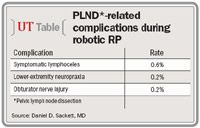Article
Lymph node dissection is feasible, safe in robotic radical prostatectomy
Pelvic lymph node dissection in patients undergoing robot-assisted laparoscopic prostatectomy is feasible, adds little time or morbidity to the procedure, and may provide important prognostic data.
Washington-Pelvic lymph node dissection in patients undergoing robot-assisted laparoscopic prostatectomy (RALP) is feasible, adds little time or morbidity to the procedure, and may provide important prognostic data, say researchers from Thomas Jefferson University in Philadelphia.
A retrospective review of 816 patients who had undergone bilateral lymph node dissection during either RALP or open radical retropubic prostatectomy found that the mean lymph node yield in the RALP cohort was 7.1, versus 6.0 for the open group (p<.0001).

The review began with 1,047 patients who had undergone radical prostatectomy between 2001 and 2009. Of those, 626 underwent RALP and 421 had the open procedure. The cohort was narrowed somewhat by the inclusion only of the 816 men who also underwent bilateral lymph node dissection.
Few complications observed
A total of 1.1% of RALP patients had nodal involvement, compared with 2.3% of open prostatectomy patients (p=.167). Mean age, preoperative PSA values, and preoperative and postoperative Gleason scores were similar between the two groups.
The investigators found five lymph node dissection-related complications (1.1%) among the RALP patients. Three were symptomatic lymphoceles (0.6%), one was lower-extremity neuropraxia (0.2%), and one was an obturator nerve injury (0.2%).
"As the data bear out, the complications from these lymphadenectomies in patients undergoing RALP are very uncommon," Dr. Sackett said. "And in the case of lymphoceles, for example, they're even less common for the laparoscopic approach than the open.
"We offer pelvic lymph node dissection to every patient with prostate cancer who will undergo a prostatectomy, regardless of the surgical approach. There are published data to support that lymph node positivity directly correlates with a decrease in biochemical recurrence-free survival."
The Thomas Jefferson team presented their findings at the 2010 American College of Surgeons Clinical Congress in Washington, and the data were published online in BJU International (Sept. 3, 2010).
Newsletter
Stay current with the latest urology news and practice-changing insights — sign up now for the essential updates every urologist needs.
















